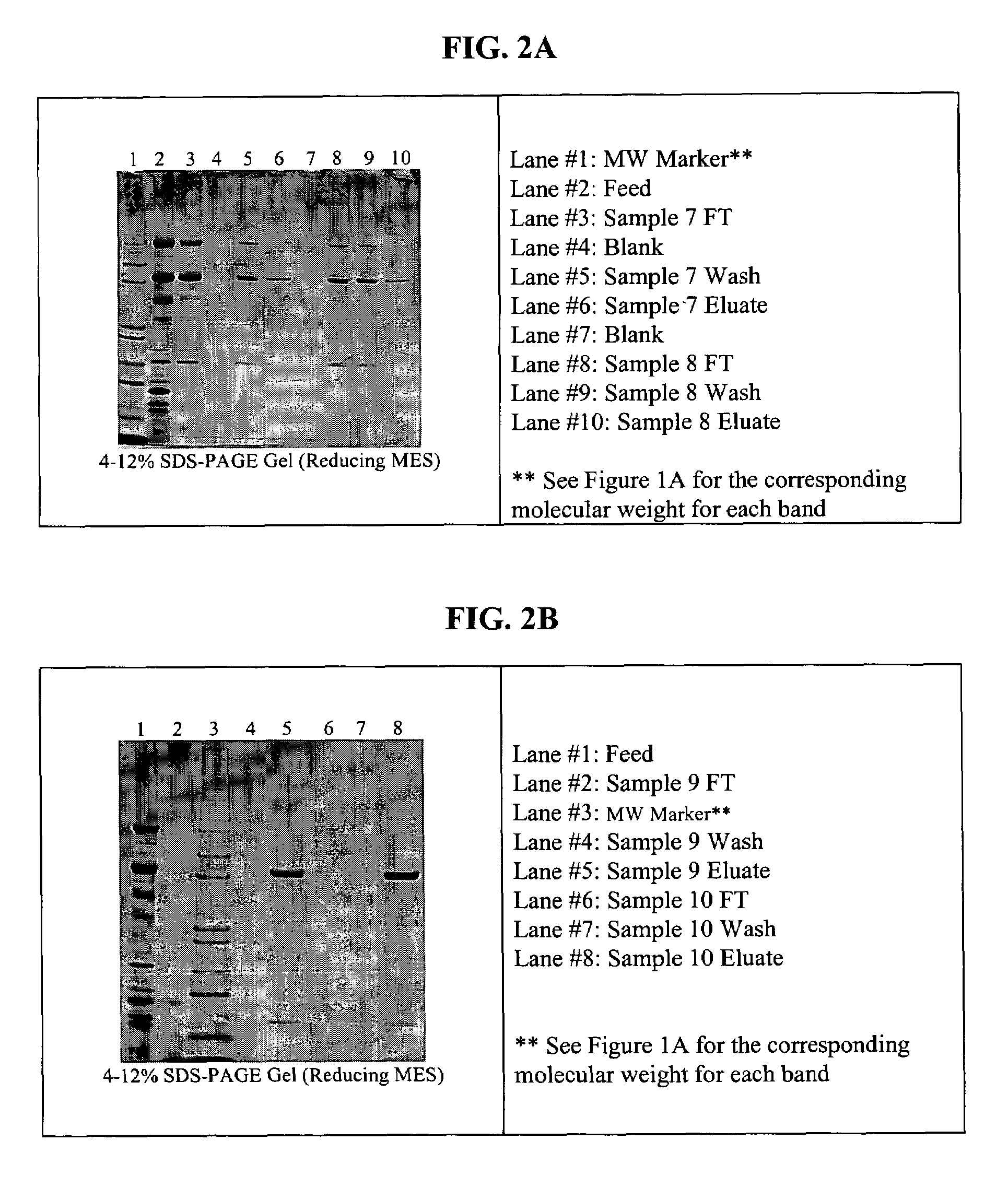Method of separating components in a sample using silane-treated silica filter media
a technology of silane-treated silica and filter media, which is applied in the direction of amphoteric ion-exchangers, water/sewage treatment by ion exchange, chemical/physical processes, etc., can solve the problems of high cost of operation, limited application of products, and difficult isolation of material of interes
- Summary
- Abstract
- Description
- Claims
- Application Information
AI Technical Summary
Benefits of technology
Problems solved by technology
Method used
Image
Examples
example 1
Preparation of Treated Rice Hull Ash Media (tRHA) Using Trialkoxysilanes in a Batch Process
[0091]The treatment equipment is composed of a 3-neck, round bottom reaction flask, a Teflon shaft mechanic stirrer, thermometer, condenser, and heating mantle around the flask. The reaction flask was loaded with ungrounded RHA silica filter media (surface area: ˜30 m2 / g), and solvent mixture. Table 1 shows the reaction conditions for each example. The mixture was stirred for a few minutes at ambient temperature, then the surface modification process involved addition of the proper amount of the silane directly to the mixture in a slow addition rate, while good mixing was maintained. 250% of the proper amount of the silane as calculated to achieve multilayer coverage (high-level treatment) or 85% of the amount of silane as calculated to achieve monolayer coverage (low level treatment) was added and the silane quantity was also corrected for their purity. The loading concentrations are also lis...
example 2
Preparation of Different Types of Treated Silica Filter Media
[0093]Additional substrates, namely high carbon rice hull ash, different types of ultra pure diatomaceous earth (Celpure P1000, Celpure P65), Celite 545 (standard diatomaceous earth filter aid), Perlite, and LRA II (a non-silica based lipid adsorbent) were used. Table 2 summarizes the treatment conditions and compositions of these samples.
[0094]
TABLE 2Compositions and conditions of treatments of different substratesSilicaSilicaLoadingAddedSampleSubstrateAmountTreatmentSilane(X MonolayerSilane#Media TypegTreatment TypeConditionPurity %coverage)g28AgriSilicas150AEAPTMSToluene, IPA,97%150%10.53STD(A 0700)reflux29Celpure100AEAPTMSToluene, IPA,97%180%0.51P1000(A 0700)reflux30Celpure50AEAPTMSToluene, IPA,97%1070% 1.53P1000(A 0700)reflux31Celpure50Z-6032Toluene, IPA,32%200%1.46P1000(SMAEAPTMS)reflux32Perlite50AEAPTMSToluene, IPA,97%200%0.24(A 0700)reflux33Perlite50Z-6032Toluene, IPA,32%200%1.21(SMAEAPTMS)reflux34Celite 54550AEAPT...
example 3
Two-step Process to Synthesize Hydrophilic Quaternary Ammonium Functional Filter Aids (Filter Media Samples 40 and 42)
[0095]The treatment equipment was composed of a 500 milliliter, 3-neck round bottom reaction flask, a Teflon shaft mechanic stirrer, thermometer, condenser, and heating mantle around the flask. The reaction flask was loaded with 50 g of amino-fimctional pretreated RHA (sample 17 or 19) silica filter media, and 200 ml IPA solvent. The mixture was stirred for few minutes at ambient temperature, then the surface modification process involved addition of the proper amount of glycidyltrimethylammonium chloride (2.46 g for sample 17, or 2.02 g for sample 19) directly to the mixture in a slow addition rate, while good mixing was maintained. The reaction mixture was heated and refluxed under a N2 blanket. After 4 hours stirring and refluxing, the treated slurry mixture was allowed to cool. Then it was transferred to a porcelain Buichner funnel outfitted with Whatman filter p...
PUM
| Property | Measurement | Unit |
|---|---|---|
| specific surface area | aaaaa | aaaaa |
| temperature | aaaaa | aaaaa |
| temperature | aaaaa | aaaaa |
Abstract
Description
Claims
Application Information
 Login to View More
Login to View More - R&D
- Intellectual Property
- Life Sciences
- Materials
- Tech Scout
- Unparalleled Data Quality
- Higher Quality Content
- 60% Fewer Hallucinations
Browse by: Latest US Patents, China's latest patents, Technical Efficacy Thesaurus, Application Domain, Technology Topic, Popular Technical Reports.
© 2025 PatSnap. All rights reserved.Legal|Privacy policy|Modern Slavery Act Transparency Statement|Sitemap|About US| Contact US: help@patsnap.com



